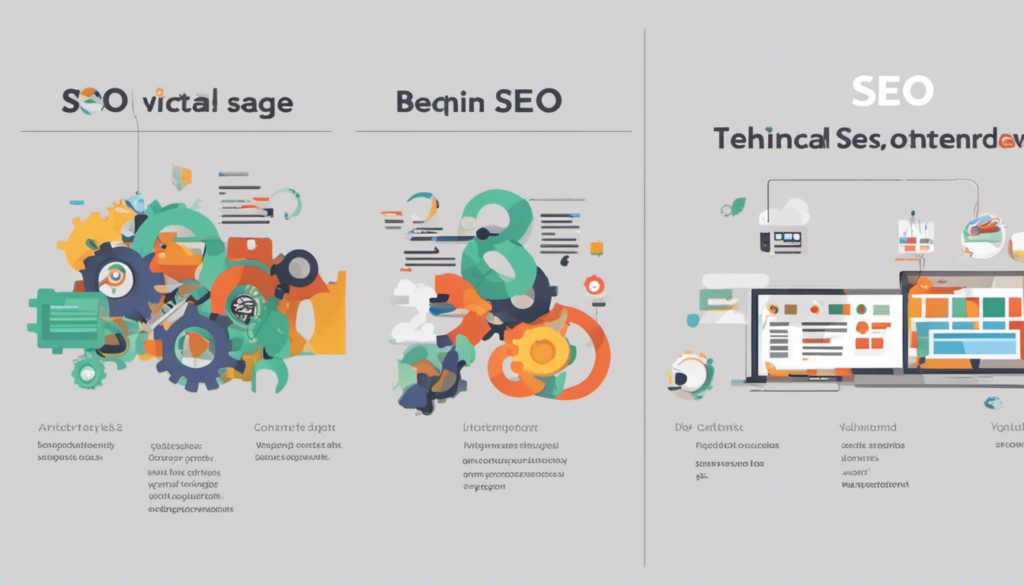When it comes to optimizing a website for search engines, two key aspects play a crucial role: On-Page SEO and Technical SEO. Both elements work hand in hand to improve a website’s visibility, search engine rankings, and user experience. Understanding the definitions and importance of On-Page SEO and Technical SEO is essential for any website owner or digital marketer looking to maximize their online presence.
Definition of On-Page SEO
On-Page SEO refers to the practice of optimizing individual web pages to improve their visibility and ranking in search engine results pages (SERPs). It involves optimizing various factors on the webpage itself, such as content, meta tags, URL structure, and internal linking, among others. The primary goal of On-Page SEO is to make the webpage more relevant, valuable, and user-friendly, which ultimately helps search engines understand the content and rank it higher.
Definition of Technical SEO
Technical SEO, on the other hand, focuses on the technical aspects of a website that influence its visibility and crawling by search engines. It involves optimizing the website’s infrastructure, performance, and security to ensure search engines can access, understand, and index the website’s content effectively. Technical SEO includes practices like website speed optimization, XML sitemap creation, robots.txt file optimization, and implementation of structured data markup, among others.
Importance of both aspects in optimizing a website
Both On-Page SEO and Technical SEO are crucial for optimizing a website and improving its search engine rankings. Here’s why:
| Aspect | Importance |
|---|---|
| On-Page SEO | Keyword optimization: By conducting thorough keyword research and optimizing the webpage’s content, On-Page SEO helps improve relevancy and attract organic search traffic. |
| User experience: On-Page SEO practices like mobile optimization, relevant content, and easy navigation enhance the user experience, leading to lower bounce rates and higher engagement. | |
| Technical SEO | Website accessibility: Technical SEO ensures that search engine crawlers can access and understand the website’s content, leading to better indexing and higher rankings. |
| Website performance: Optimizing website speed and performance enhances user experience, reduces bounce rates, and positively impacts search engine rankings. |
Ultimately, a successful SEO strategy requires a balanced approach that combines the power of On-Page SEO and Technical SEO. By optimizing the content and technical aspects of a website, businesses can attract more organic traffic, improve search engine rankings, and provide a seamless user experience. In the following sections, we will delve deeper into the key factors and best practices of both On-Page SEO and Technical SEO.
On-Page SEO
On-Page SEO refers to the practice of optimizing individual web pages to improve their search engine rankings and attract organic traffic. It involves optimizing various elements on a webpage to make it more search engine-friendly and user-friendly. By focusing on On-Page SEO, website owners can improve their chances of ranking higher in search engine results pages (SERPs) and increase their visibility to potential visitors.
Key factors and best practices for On-Page SEO
- Keyword research and optimization: Conducting thorough keyword research helps identify relevant and high-traffic keywords to target. Optimizing web page content with these keywords, including in titles, headings, and throughout the body, helps search engines understand the page’s topic and rank it accordingly.
- Content quality and relevance: Creating high-quality and relevant content is crucial for On-Page SEO. Search engines prioritize valuable and informative content that satisfies user intent. It is essential to provide unique and engaging content that incorporates relevant keywords naturally.
- Meta tags optimization: Optimizing meta tags, including the meta title and meta description, helps search engines understand what the webpage is about. A compelling meta title and description can also attract users to click on the webpage from the search results.
- URL structure and optimization: Creating clean and descriptive URLs that include relevant keywords can improve On-Page SEO. It is important to keep URLs concise, readable, and relevant to the webpage’s content.
- Internal linking and anchor text optimization: Internal linking refers to linking relevant pages within a website. It helps search engines understand the website’s structure and establishes relationships between different pages. Optimizing anchor text with relevant keywords helps search engines determine the context of the linked page.
- Mobile optimization and responsive design: With the increasing use of mobile devices, optimizing web pages for mobile responsiveness is crucial. Mobile-friendly websites have better chances of ranking higher in mobile search results. Implementing responsive design ensures that the website adapts to different screen sizes and provides a user-friendly experience.
By focusing on On-Page SEO, website owners can benefit from improved search engine rankings and increased organic traffic. Optimizing key factors such as keyword research, content quality, meta tags, URL structure, internal linking, and mobile optimization helps improve the overall user experience and enhances the website’s visibility in search results.
Technical SEO
Technical SEO refers to the optimization of a website’s technical elements to improve its visibility and ranking in search engine results. It focuses on enhancing the website’s performance, accessibility, and user experience. By implementing technical SEO best practices, website owners can ensure that search engines can crawl, understand, and index their site effectively.
Key factors and best practices
- Website speed and performance optimization: A fast-loading website is crucial for both user experience and search engine rankings. Optimizing images, minifying CSS and JavaScript files, and leveraging browser caching are some of the techniques used to improve website speed.
- XML sitemap creation and submission: XML sitemaps act as a roadmap for search engines, helping them discover and index all the important pages on a website. Creating and submitting an XML sitemap ensures efficient crawling and indexing.
- Robots.txt file optimization: The robots.txt file instructs search engine crawlers which pages and directories to crawl and which to exclude. Optimizing this file helps control the crawling and indexing process, ensuring that search engines focus on the most important pages.
- Canonicalization and duplicate content management: Canonical tags help specify the preferred version of a webpage, especially when duplicate content exists. By implementing canonical tags correctly, website owners can consolidate link equity and avoid penalties for duplicate content.
- Structured data markup implementation: Structured data markup provides additional information about a webpage’s content to search engines. This markup helps search engines understand and display the content more accurately, leading to enhanced visibility and click-through rates.
- Website security and HTTPS implementation: Website security is not only essential for protecting user data but also for SEO. Switching to HTTPS ensures a secure connection, which can boost search engine rankings while instilling trust in users.
Benefits of focusing on Technical SEO
Focusing on technical SEO brings several benefits that can positively impact a website’s search engine visibility and user experience. Here are the key benefits:
- Improved crawlability and indexation: By implementing technical SEO best practices, website owners make their site more accessible and understandable for search engine crawlers. This leads to better indexation and visibility in search engine results.
- Enhanced website performance: Optimizing technical aspects such as website speed and performance improves user experience. A fast-loading website reduces bounce rates and encourages users to stay longer, increasing the chances of conversions and higher search engine rankings.
- Increased organic search visibility: Implementing structured data markup and other technical optimizations can lead to rich snippets in search engine results. These enhanced listings attract more clicks, driving organic traffic to the website.
- Better user experience: Technical SEO optimizations contribute to a seamless user experience. A well-structured website with easy navigation and quick load times enhances user satisfaction, leading to increased engagement and conversions.
By focusing on technical SEO, website owners can ensure that their site is optimized for search engines, providing a solid foundation for higher visibility, improved user experience, and ultimately, SEO success.
On-Page SEO vs Technical SEO: Similarities and Differences
Both On-Page SEO and Technical SEO are crucial aspects of optimizing a website for search engines. While they share similarities in terms of optimizing a website, they also have unique areas of focus that contribute to overall SEO success.
Overlapping elements and practices
On-Page SEO and Technical SEO have several overlapping elements and practices that are essential for website optimization. These include:
- Keyword optimization: Both aspects require keyword research and optimization to improve search engine visibility and rankings.
- Content quality: On-Page SEO and Technical SEO both emphasize the importance of high-quality, relevant content that engages users and provides value.
- Meta tags optimization: Optimizing meta tags, such as title tags and meta descriptions, is important for both On-Page SEO and Technical SEO to improve click-through rates and search engine visibility.
Areas of focus unique to each aspect
While there are overlapping elements, On-Page SEO and Technical SEO also have unique areas of focus that distinguish them from each other. These areas include:
| On-Page SEO | Technical SEO |
|---|---|
| URL structure and optimization | Website speed and performance optimization |
| Internal linking and anchor text optimization | XML sitemap creation and submission |
| Mobile optimization and responsive design | Robots.txt file optimization |
In On-Page SEO, the focus is on optimizing individual web pages to improve their visibility and relevance to target keywords. This includes optimizing URL structures, internal linking, and ensuring mobile-friendly design. On the other hand, Technical SEO focuses on the technical aspects of a website, such as improving website speed, creating XML sitemaps, and optimizing robots.txt files.
How they complement each other in optimizing a website
While On-Page SEO and Technical SEO have distinct areas of focus, they work together to optimize a website for search engines. On-Page SEO ensures that the content and structure of individual web pages are optimized for target keywords and user experience. Technical SEO, on the other hand, focuses on the technical aspects that support the website’s overall performance and accessibility.
By implementing both strategies, website owners can achieve a comprehensive optimization approach that improves search engine visibility, user experience, and overall website performance. On-Page SEO and Technical SEO complement each other by addressing different aspects of website optimization and working in harmony to enhance a website’s chances of ranking higher in search engine results.
Therefore, it is important to strike a balance between On-Page SEO and Technical SEO to ensure a holistic approach to website optimization.
Importance of Balancing On-Page SEO and Technical SEO
When it comes to achieving SEO success, it’s crucial to strike a balance between On-Page SEO and Technical SEO. Both aspects play a significant role in optimizing a website for search engines and ensuring its visibility in search results.
On-Page SEO focuses on optimizing the content and structure of individual web pages to improve their relevance to target keywords and enhance the user experience. This includes keyword research and optimization, creating high-quality and relevant content, optimizing meta tags and URLs, implementing internal linking strategies, and ensuring mobile optimization. By paying attention to these factors, businesses can improve their website’s visibility and attract organic traffic.
Technical SEO, on the other hand, deals with the behind-the-scenes aspects of website optimization. It involves addressing technical issues that can affect a website’s performance and crawlability by search engines. Key factors in technical SEO include website speed and performance optimization, XML sitemap creation and submission, robots.txt file optimization, canonicalization, structured data markup implementation, and website security. By focusing on these technical aspects, businesses can ensure that their website is easily accessible to both search engines and users.
To understand the importance of balancing On-Page SEO and Technical SEO, let’s take a look at some case studies and examples. In a study conducted by Moz, it was found that websites with a balanced approach to both On-Page SEO and Technical SEO saw significant improvements in their search engine rankings and organic traffic. This highlights the importance of considering both aspects in an SEO strategy.
| Website | On-Page SEO | Technical SEO | Organic Traffic Increase |
|---|---|---|---|
| Website A | Implemented keyword optimization and content improvements | Optimized website speed and fixed crawlability issues | 30% |
| Website B | Optimized meta tags and URLs | Implemented structured data markup and improved website security | 50% |
| Website C | Improved internal linking and anchor text optimization | Optimized XML sitemap and fixed canonicalization issues | 40% |
While both On-Page SEO and Technical SEO are essential, it’s important to note that they cannot exist in isolation. User experience plays a vital role in SEO, and a holistic approach that takes into account both aspects is necessary. A website that is optimized for search engines but lacks user-friendly design and navigation may not achieve the desired results.
By balancing On-Page SEO and Technical SEO, businesses can create a website that is not only visible to search engines but also provides a seamless and engaging experience to users. This, in turn, can lead to increased organic traffic, higher conversions, and ultimately, SEO success.
Both On-Page SEO and Technical SEO are of utmost significance in a comprehensive SEO strategy. Neglecting either aspect can limit the effectiveness of your efforts. On-Page SEO ensures that your website’s content is optimized for relevant keywords and provides a seamless user experience. Meanwhile, Technical SEO ensures that search engines can crawl and index your website effectively.
By implementing a balanced approach, you can create a solid foundation for your website’s SEO success. Your content will be optimized for search engine visibility, while your website’s technical aspects will be fine-tuned for optimal performance. This holistic strategy allows you to maximize your website’s potential and improve its visibility in search engine results.
| On-Page SEO | Technical SEO |
|---|---|
| Keyword research and optimization | Website speed and performance optimization |
| Content quality and relevance | XML sitemap creation and submission |
| Meta tags optimization | Robots.txt file optimization |
| URL structure and optimization | Canonicalization and duplicate content management |
| Internal linking and anchor text optimization | Structured data markup implementation |
| Mobile optimization and responsive design | Website security and HTTPS implementation |
Implementing a balanced approach to On-Page SEO and Technical SEO will not only improve your website’s visibility in search engine results, but it will also enhance the overall user experience. A well-optimized website that loads quickly, offers relevant and high-quality content, and is easy to navigate will attract and retain more visitors.
It’s essential to remember that SEO is an ongoing process, and regularly revisiting and fine-tuning both On-Page SEO and Technical SEO practices is crucial for long-term success. By staying up to date with the latest SEO trends and best practices, you can continue to improve your website’s visibility, organic traffic, and ultimately, the success of your online presence.
FAQ about On-Page SEO vs Technical SEO
What is On-Page SEO?
On-Page SEO refers to the optimization techniques and practices implemented directly on a website to improve its search engine rankings. It involves optimizing elements such as keywords, content, meta tags, URL structure, internal linking, and mobile responsiveness.
What is Technical SEO?
Technical SEO focuses on optimizing the technical aspects of a website to improve its visibility and crawling ability by search engines. It involves optimizing factors like website speed, XML sitemaps, robots.txt file, canonicalization, structured data markup, and website security.
How do On-Page SEO and Technical SEO differ?
While both On-Page SEO and Technical SEO contribute to a website’s search engine optimization, they focus on different areas. On-Page SEO deals with optimizing the content and structure of a website, while Technical SEO focuses on improving the technical aspects that affect a website’s visibility and performance.
Are there any similarities between On-Page SEO and Technical SEO?
Yes, there are overlapping elements and practices between On-Page SEO and Technical SEO. Both aspects require keyword research and optimization, as well as the management of duplicate content. Additionally, both On-Page SEO and Technical SEO contribute to improving the overall user experience of a website.
Why is it important to focus on both On-Page SEO and Technical SEO?
A balanced approach to SEO that includes both On-Page SEO and Technical SEO is crucial for achieving optimal results. On-Page SEO ensures that the website’s content is relevant and valuable to users, while Technical SEO ensures that the website is accessible, fast, and secure. Ignoring either aspect can hinder the website’s overall search engine performance.
Can you provide examples of the impact of a balanced approach?
Certainly! Many case studies have shown that implementing a balanced approach to On-Page SEO and Technical SEO can lead to significant improvements in organic search traffic, rankings, and overall user experience. Websites that prioritize both aspects often see increased visibility, higher click-through rates, and improved conversions.
How does user experience contribute to the success of SEO?
User experience plays a crucial role in SEO. Search engines aim to provide users with the most relevant and valuable websites in their search results. Websites that offer a seamless user experience, such as fast loading times, easy navigation, and high-quality content, are more likely to rank well. By focusing on both On-Page SEO and Technical SEO, website owners can ensure that their website meets the expectations of both search engines and users.
Remember, implementing a balanced approach to On-Page SEO and Technical SEO is key to achieving optimal results in search engine optimization. By prioritizing both aspects and continuously monitoring and adjusting your strategies, you can improve your website’s visibility, user experience, and ultimately, its success in search engine rankings.

I am Kirill, the CEO of KeyRealSeo. I’m an SEO aficionado, always riding the wave of the latest technologies and integrating them seamlessly into my processes.





